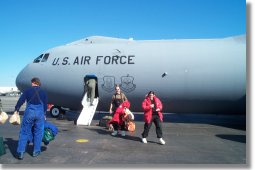Getting There
Getting to Antarctica has never been easy. Of course, it's a lot easier now than it was in 1820 when Nathaniel Palmer first sighted the continent from his ship Hero, or at the turn of 20th century when Amundsen, Scott, Shackleton, and other polar explorers began traveling across the continent in their race for the South Pole.
But for those accustomed to the comforts of modern travel, the trip
to Antarctica can still be a long, hard haul. For the IVARS crew,
the trip begins at the airport in Richmond, Newport News, or Norfolk.
From there it's a 3-or-so hour flight to a connecting city such as
Dallas, then another 3-hour flight to Los Angeles. Then it's a 12-hour
red-eye across the Equator and International dateline to
Auckland, New Zealand. 
After passing through customs in Auckland, it's onto yet another plane for the 2-hour flight to Christchurch, the "gateway to Antarctica" since the days of the early polar explorers.
Arriving in Christchurch is a surreal experience. In addition to the 18-hour time difference and lack of sleep, there's the paradox of austral seasonality. Most Antarctic research, including the IVARS cruises, is scheduled for the southern hemisphere summer (Dec-Feb). Of course summer in Antarctica is winter most everywhere else, but summer in Christchurch can be quite pleasant and warm. When we step off the plane it's 72 degrees, sunny, and flowers are blooming everywhere. The trees are in full leaf, smells of summer fill the air, and it will stay light until 10 pm. Quite a shock compared to the ice storm that was raging when we left Virginia 24 hours earlier.
The sudden appearance of summer in the middle of our journey from the northern hemisphere winter to the Antarctic ice is a welcome surprise but also a bit disconcerting. It makes packing a bit challenging as well—in addition to all the cold weather gear we need for Antarctica, we also have to make room for shorts and sandals.
This paradox is nowhere more apparent than at the Clothing Distribution Centre (CDC) at the U.S. Antarctic Program headquarters in Christchurch. Before we can board our flight to McMurdo Station, we're required to try on the Extreme Cold Weather (ECW) gear that the CDC staff has issued. So we step from a warm summer day into an air-conditioned warehouse whose floor is covered with orange duffel bags stuffed with giant red parkas, huge fur-covered mittens, bunny boots, balaclavas, neck gaiters, long underwear, fleece jackets, wind pants, snow goggles, wool socks, and every other piece of winter clothing you could possibly imagine. Then we have to try on every piece to make sure it fits-all while looking out the window at rows of blooming petunias.
The paradox becomes even more pronounced the next morning when we have to don all this gear for the flight to Antarctica. This requirement seems a bit ludicrous as we pass through New Zealand customs, step outside into yet another warm summer day, and immediately begin sweating in the heat. A few hours later it will make more sense, but first we have to get onto the C-141 "Starlifter" for our 6-hour flight to the ice.
The C-141 flight is one of those experiences that's made bearable only because it's novel. An adventurous person would do it once for the experience, but it would take a special breed to do it again eagerly.
These polar C-141s were built in the 1960s for hauling military troops and cargo, and both their age and purpose are clearly visible the moment you duck through the door. A member of the Air National Guard herds us down aisles on either side of the fuselage, then belts each of us into a seat of nylon webbing suspended from long aluminum rods. We sit facing each other across a space so narrow that we have to hold our feet splayed sideways like ducks (it doesn't help that we are all wearing bunny boots the size of small snowshoes). After the crew has shoehorned all 71 passengers into their seats, some small talk begins, but it quickly stops the moment the engines rev up. The roar is so loud that we all immediately insert the earplugs we were given earlier, and for the rest of the flight all conversations take place through hand signals, shoulder shrugs, or the occasional shout. As the flight progresses and various body parts begin falling asleep, the seasoned passengers take off their bunny boots and stand up in their seats. It's the only way to get comfortable, and soon most of those who aren't sleeping (and some who are) are standing up.
The interior of the plane makes us appreciate all that commercial airliners do to keep their passengers comfortable and secure. In addition to the lack of acoustic insulation and leg room, the most striking differences between the C-141 and a typical commercial airliner are the lack of windows (only four along the passenger compartment), the nature of the restroom "facilities," and the appearance of the mechanical systems. The bathroom on a Boeing 727 might be small and somewhat difficult to use, but it has to beat a funnel welded to a 55-gallon drum that's hidden inside a circular shower curtain for privacy (there is supposedly a real bathroom somewhere onboard, which is reserved for crew and female passengers). And unlike a commercial airliner, which wisely hides its mechanical systems out of sight and out of mind, here all the old and worn widgets are in plain sight. Look up and you see air ducts held together with duct tape and what appear to be shoelaces, miles of wire spliced here and there with electrician's tape, scores of cables and pulleys like you'd see on a carnival ride, and hydraulic lines marked with cryptic warning signs and symbols.
But the flight goes smoothly, and 3 days and 25 air hours after leaving Virginia, we touch down on the Ross Ice Shelf.

